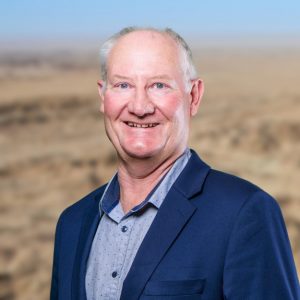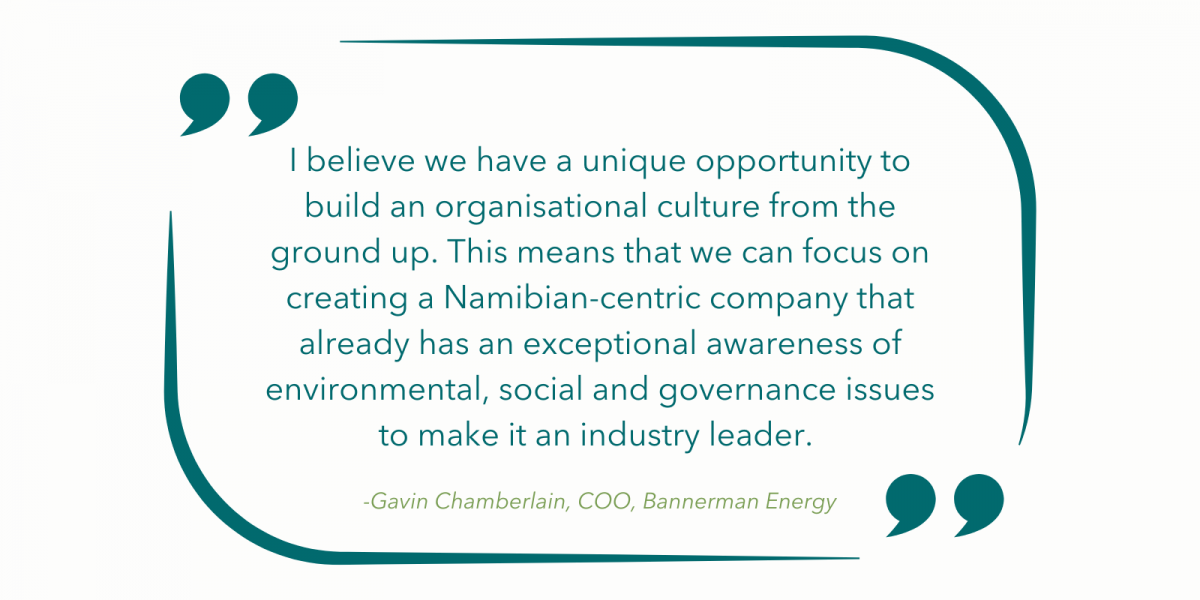Chamber of Mines Economist Lauren Davidson recently interviewed Gavin Chamberlain, Bannerman Energy’s newly appointed Chief Operating Officer.
LD: Tell us about yourself, who is Gavin Chamberlain?
GC: I grew up in a small town (Ladysmith Natal) in a farming community. Following my school education in Ladysmith I obtained my engineering degree in civil from the University of Natal, then continued to further my studies with a Graduate Diploma in Waste and Geotechnical design at Wits.
Professionally, I have been involved in the mining industry for over 30 years. In this time, I have been involved in mining projects throughout Africa. I started as a designer and then switched to contracting before moving to project management and then onto the client’s side as Chief Operating Officer. This have given me a well-rounded view of the mining industry.
I’m fortunate to be happily married to Liz for 32 years. Our common interests include travelling, wildlife conservation, diving, and photography.

LD: How would you describe your management style?
GC: I have been extremely lucky in my career where I been given lots of responsibility and encouraged to grow my management experience. I would describe my management style as “servant leader” – I would rather focus on enabling the people around me to do their jobs as best possible than issue instructions on how they should do their jobs. The best lesson I have learnt in my career is that as a manager or project manager you are not expected to have all the answers – but are expected to ask the questions and let your team assist in finding solutions.
LD: Why did Bannerman bring you on board?
GC: My role is to lead the construction of the Etango uranium project and bring the mine into production. Apart from the well-rounded experience I have received in the mining industry I was also the Project Director of the EPCM (Engineering Procurement Construction Management) JV that built the Husab Uranium mine, which is next door to Etango in Erongo region. I believe this experience, along with an alignment of the company strategy with my own personal beliefs were attractive to the company.
LD: What excites you about the next 12 months?
GC: I believe we (Bannerman) have a unique opportunity to build an organisational culture from the ground up. This means that we can focus on creating a Namibian-centric company that already has an exceptional awareness of environmental, social and governance issues to make it an industry leader. This has also been confirmed by my interaction with the Board who are fully supportive of “getting it right” from the start.
With the excellent work I have seen on the Etango DFS and the culture that the Bannerman team have created over the last decade, it excites me to see the Etango Project move into execution and have the opportunity to lead construction.
We will start with recruitment processes that will need to focus on finding self-starting Namibians that want to be involved in a company that believes in Namibia, Uranium and leading the way towards operating under an industry leading environmental, social and governance guidelines. It excites and challenges me to be part of building a team capable of meeting this vision.
I must also admit it excites just to be involved in Namibia again. When working here on Husab I fell in love with your country!
LD: Why did you decide to join Bannerman? What attracted you to the company and what was your decision-making process?
GC: I am someone who thrives on problem solving, so to be involved with a greenfields project in a single-mine company ticked all my personal boxes. I did extensive due diligence and concluded that Etango is closest to construction-ready of all the projects in close proximity to my home base. Perhaps more importantly, I am at the point in my career where I want to give back – and saw the opportunity to apply my skills and experience to a project that will have a huge positive impact on Namibia and the nuclear power industry.
In the recruitment process (which was an extensive and thorough international search) I had an opportunity to interrogate Brandon (Bannerman Energy CEO, Brandon Munro) on strategy and company philosophy and found I was aligned with his vision for the development of both the project and the company.
What then remained was understanding the people I would be working with. I was pleased to find an exceptional level of executive and board capability and an unusual degree of alignment on the company’s sense of purpose.
LD: What sort of start did you have at Bannerman?
GC: In one word, hectic! Talk about sink or swim.
My first day was the 121 Investment Conference in Cape Town in February, a fantastic opportunity for me to fast track my in-depth understanding of Etango while Brandon fielded hours on hours of investor questions. It was also a great chance to meet a number of the role players that Bannerman are engaging with. I then flew with Brandon from Cape Town to Namibia to spend two weeks with the Bannerman team and Board. My induction was intense, covering Etango and Lofdal site visits, numerous stakeholder engagements including functions in Swakopmund and Windhoek and a two-day strategic planning session in the bush. I met the Minister, Deputy Minister, and Mining Commissioner, reminding me how lucky we are to have that accessibility to government.
I don’t think there is a better way of becoming immersed in a company culture than this, it was a case of experiencing instead of being told and left a really positive feeling.
LD: How does your role differ from Bannerman’s Managing Director Namibia – Werner Ewald?
GC: Werner has been with Bannerman for a decade and in this time, he has established Bannerman’s reputation in Namibia based on his personal integrity, impressive work ethic and deep industry experience gained at Rossing. As we move from DFS to construction, Werner will continue to lead Bannerman Namibia, whereas my role is more focussed on project delivery and applying my experience to ensure the mine construction is a success. Our skill sets are different but complimentary, with Werner having deep mining operational experience, while my experience is more construction and project focused. The very nature of the two roles means we will work with each other in furthering the future of Bannerman as an entity.
LD: Applying your decades of experience, what is your assessment of the Etango project?
GC: Obviously I think very highly of the project, which was the most important part of my decision to join Bannerman.
Bannerman completed a high-quality DFS in December last year. The company has sufficient cash to enable it to immediately move forward with Front End Engineering and Design, which is often only commenced once debt funding is arranged. This means the project is highly advanced and will be construction-ready once debt funding is secured and a Final Investment Decision is made.
The project has low technical risk. It is a simple and conventional open pit mine that looks a lot like Rossing. The key difference – Etango utilises sulphuric acid heap leaching – has been extensively proven by Bannerman running the Heap Leach Demonstration Plant for several years.
My job is much easier because Namibia has excellent road, rail, water and power infrastructure in place and the added benefit of a port facility that has been exporting product for almost 50 years.
Finally, the Etango ore body is massive that enhances its long-term positive impact. Whilst, the initial mine life is 15 years, there is ample capacity to expand the mine either through extending the mine life and/or increasing production capacity. I believe that Etango has the potential to have a similar impact to Rossing, which started in the 1970’s with a 16-year mine life and yet will produce for more than 50 years.
LD: What are the key differences between constructing Husab & Etango?
GC: The obvious difference is scale, the Husab project was a mega mining project worth over US$2 billion (N$40 billion) compared to Etango with a capital cost of US$317 million (N$6 billion). My own role is also different from that of being EPCM Project director to now working on the Owners side. Technically, Husab was also more complex with IX and SX circuits as opposed to Etango which is conventional with a heap leach and IX/Nano filtration circuit.
LD: What is your biggest challenge?
GC: Finding the right staff to match our vision of a Namibian-centric operation that is a world leader in uranium production will be challenging. This is a challenge because it’s not just about finding skills – we also need people with passion and the right attitude. We believe the people are here and that we need to identify them early. Then we need to focus on building a learning culture where people are encouraged to make decisions without fear and grow through exposure to issues. Once we succeed, Etango will be one of the most inspiring places to work in Namibia.
For more information on Bannerman, visit https://bannermanenergy.com/

